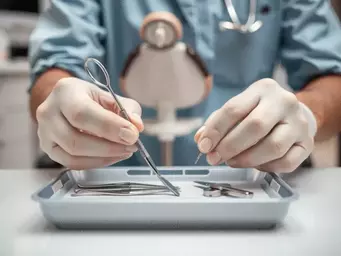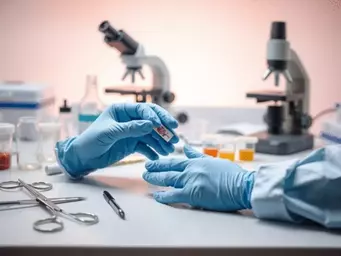Have you ever felt overwhelmed upon receiving a medical report, unsure of the terminology and implications it holds? Understanding your biopsy report is crucial, as it can significantly influence your health journey and treatment decisions. Let’s break down the essential takeaways that will empower you to navigate your health with confidence.
What You Will Learn
- Understanding the difference between benign and malignant results is fundamental in determining your treatment options.
- Knowing your cancer's grade and stage helps in developing a personalized treatment plan.
- Familiarizing yourself with key components of your pathology report can provide clarity about your health status.
- Different types of biopsies, such as needle and surgical biopsies, serve specific diagnostic purposes that are essential to understand.
- Awareness of histopathology can shed light on cellular abnormalities and guide treatment decisions.
- Asking the right questions during your medical discussions will empower you and reduce anxiety about your health.
- Seeking support from patient communities can enhance your understanding and provide emotional reassurance.
Biopsy Report Key Terms: Benign vs. Malignant & Grade vs. Stage
Understanding the fundamental differences between benign and malignant conditions, as well as cancer grade and stage, is crucial for interpreting your biopsy report and making informed healthcare decisions.
Benign vs. Malignant
Benign
- Non-cancerous growths
- Usually do not spread
- Generally not a serious health risk
Malignant
- Cancerous cells
- Can invade nearby tissues
- May spread to other body parts
Cancer Grade vs. Stage
Cancer Grade
- How abnormal cells appear
- Indicates aggressiveness
- Example: Grade 1 (low grade, slow-growing)
Cancer Stage
- Extent of cancer in the body
- Size and spread (lymph nodes, organs)
- Example: Stage I (localized) vs. Stage IV (advanced)
Understanding Your Biopsy Report: Key Terms Explained
Receiving your biopsy report can feel overwhelming, especially if you're not familiar with medical terminology. However, understanding the key terms can empower you to take charge of your health. Let’s break down some of the most important concepts you may encounter in your report.
One of the first things you might see are terms like "benign" and "malignant." While these words can seem intimidating, they serve a vital purpose in helping you comprehend your diagnosis. Knowing the difference can significantly impact your treatment options.
What Do Benign and Malignant Mean?
When discussing biopsy results, the terms benign and malignant frequently come up. A benign result indicates that the cells are not cancerous and generally do not pose a serious health risk. On the other hand, a malignant result means that the cells are cancerous and may require further action. Understanding these terms can help reduce your anxiety about what comes next!
- Benign: Non-cancerous growths that usually do not spread.
- Malignant: Cancerous cells that can invade nearby tissues and spread to other parts of the body.
- Both terms play a crucial role in determining the next steps in your treatment journey.
It’s essential to remember that a benign diagnosis is a relief for many patients, while a malignant diagnosis can feel daunting. However, early detection and proper treatment can lead to positive outcomes!
Defining Cancer Grade and Stage: Why It Matters
Two terms that often appear in your biopsy report are cancer grade and stage. The grade refers to how abnormal the cancer cells appear under a microscope, which helps indicate how aggressive the cancer might be. The stage, meanwhile, describes the extent of cancer in your body, including its size and whether it has spread to nearby lymph nodes or other organs.
- Grade 1: Low grade, resembling normal cells, typically slow-growing.
- Stage I: Early stage, localized cancer without spread.
- Stage IV: Advanced cancer that has spread to distant sites.
Being aware of your cancer's grade and stage is crucial because it helps you and your healthcare team develop a personalized treatment plan. This knowledge can empower you to make informed decisions about your care!
Decoding Your Pathology Report: Essential Components
Your pathology report is packed with important information about your biopsy results, and it can be helpful to understand its key components. Typically, it includes details such as the type of tissue sampled, the presence of any abnormal cells, and specific markers that can guide treatment options. For a more detailed understanding of what’s in a pathology report, you can refer to resources like the American Cancer Society's guide.
- Type of biopsy: Indicates the method used to obtain the sample (e.g., needle biopsy, surgical biopsy).
- Histological findings: Describes the appearance of cells and whether they are cancerous.
- Immunohistochemical markers: Tests for specific proteins that inform treatment decisions.
Reading and understanding your pathology report can provide clarity and ease your worries. If you have any questions, don’t hesitate to ask your doctor for explanations—they’re here to help!
Exploring Different Biopsy Types: How They Affect Diagnosis
Biopsies come in various types, each tailored to specific situations. Understanding these differences can enhance your understanding of your diagnosis and treatment options. For more information on the different types of biopsies and their diagnostic purposes, you can consult sources like Wikipedia's detailed explanation of biopsies. Here are some common types of biopsies:
- Needle biopsy: A thin needle is used to extract tissue, often guided by imaging techniques.
- Surgical biopsy: A small section of tissue is surgically removed, providing a larger sample for analysis.
- Skin biopsy: Used to examine skin lesions, usually by shaving, excision, or punch methods.
Each type of biopsy has its advantages depending on the location and nature of the suspected issue. Understanding these can help you feel more informed about your healthcare choices.

Understanding Histopathology: What Your Lab Results Reveal
Histopathology is the study of tissues under a microscope to identify diseases. Your lab results will often summarize the histopathological findings, which can offer vital insights into your health. These findings help doctors understand the nature of the cells they analyzed and whether any treatment is necessary.- Tumor type: Identifying the specific type of cancer or condition.
- Cellular features: Examining the shape and arrangement of cells to determine abnormalities.
- Presence of inflammation: Indicating how your body is reacting to a potential threat.
By demystifying the histopathological aspects of your report, you can better grasp what your results mean and how they can impact your next steps. Remember, you’re not alone in this—knowledge is power!
Pro Tip
When reviewing your biopsy report, consider keeping a health journal. Document your questions, concerns, and any new information you learn. This practice not only helps you track your health journey but also prepares you for meaningful discussions with your healthcare provider.
Frequently Asked Questions About Biopsy Reports
- What is the difference between a benign and malignant biopsy result?
- A benign result means the growth is non-cancerous and generally not a serious health risk, while a malignant result indicates cancerous cells that may invade nearby tissues and spread.
- Why are cancer grade and stage important?
- Cancer grade indicates how abnormal the cancer cells appear (aggressiveness), and cancer stage describes the extent of cancer in the body (size and spread). Both are crucial for developing a personalized treatment plan.
- What information can I expect to find in my pathology report?
- Your pathology report typically includes the type of biopsy performed, histological findings (description of cells), and immunohistochemical markers that guide treatment decisions.
- What are the common types of biopsies?
- Common types include needle biopsies (using a thin needle), surgical biopsies (removing a tissue section), and skin biopsies (for skin lesions).
- What does histopathology reveal about my health?
- Histopathology involves studying tissues under a microscope to identify diseases, revealing the tumor type, cellular features, and presence of inflammation, which are vital for diagnosis and treatment planning.
- How can I ensure I'm receiving reliable health information online?
- To find reliable health information online, look for websites from government agencies, educational institutions, and reputable health organizations. Resources like the National Institute on Aging's guide can help you evaluate online health information.
Summarizing Key Takeaways from Your Biopsy Discussion
After your biopsy discussion, it’s essential to reflect on what you've learned. This is not just about understanding the technical aspects but also about gaining clarity on your health journey. Here are some important questions to consider asking your doctor:
- What do my results mean for my overall health?
- Are there any additional tests needed to clarify my diagnosis?
- What are the next steps I should be aware of?
- How can I best prepare for upcoming appointments?
By addressing these questions, you can navigate your next steps with greater confidence. Remember, knowledge is power! The more you understand, the less anxiety you may feel.

Encouragement to Seek Support and Stay Informed
It’s natural to feel a mix of emotions after discussing your biopsy results. I encourage you to seek support from friends, family, or even patient advocacy groups. Connecting with others who have faced similar challenges can provide comfort and useful insights. Here are some ways to stay informed:
- Follow reputable health websites focused on patient education.
- Join online forums or social media groups dedicated to health discussions.
- Consider speaking with a patient advocate for personalized assistance.
Staying informed not only helps you feel more in control but also empowers you to make decisions regarding your health. Don’t hesitate to reach out for the support you deserve!
Next Steps: Empowering Yourself in Your Health Journey
As you move forward in your health journey, there are several empowering steps you can take. Utilizing technology can be a game-changer in managing your health effectively. Here are some digital tools and apps to consider:
- Health tracking apps to monitor symptoms and medications.
- Appointment reminders to keep you organized.
- Information resources that provide updates on your condition.
These tools can help you stay proactive and engaged in your healthcare experience. Remember, staying on top of your health is a journey, and every step counts!
Connecting with Support Resources and Patient Communities
Finding community support can significantly enhance your journey. Don’t hesitate to explore resources like local support groups or online platforms where you can connect with others facing similar challenges. Here’s how you can get involved:
- Search for local support groups through hospitals or community centers.
- Join online forums dedicated to specific health concerns.
- Participate in workshops or seminars focused on patient empowerment.
Being part of a community can provide not only emotional support but also practical advice. You are not alone, and there are many who can share their experiences with you.
Understanding Clinical Trials: What You Need to Know
Clinical trials can offer valuable options for many patients. If you're considering this path, it's essential to understand what to expect. Here’s a quick overview:
- Clinical trials often test new treatments or procedures.
- Participation is voluntary, and you can withdraw at any time.
- Be sure to ask about potential risks and benefits before enrolling.
Discussing clinical trials with your doctor can open up new possibilities for your treatment journey. Remember, staying informed and proactive is key to navigating your health effectively!
Recap of Key Points
Here is a quick recap of the important points discussed in the article:
- Benign vs. Malignant: Understanding these terms is crucial; benign means non-cancerous, while malignant indicates cancerous cells that may require further action.
- Cancer Grade and Stage: Grade indicates how abnormal cancer cells look, while stage describes the extent of cancer spread, essential for treatment planning.
- Pathology Report Components: Key elements include type of biopsy, histological findings, and immunohistochemical markers that guide treatment options.
- Types of Biopsies: Different methods such as needle, surgical, and skin biopsies are tailored for specific situations to enhance diagnosis.
- Histopathology Insights: Understanding tumor type, cellular features, and inflammation presence can help clarify your health status.
- Engagement with Healthcare: Always ask questions, clarify your understanding, and don’t hesitate to seek support from healthcare professionals and communities.









